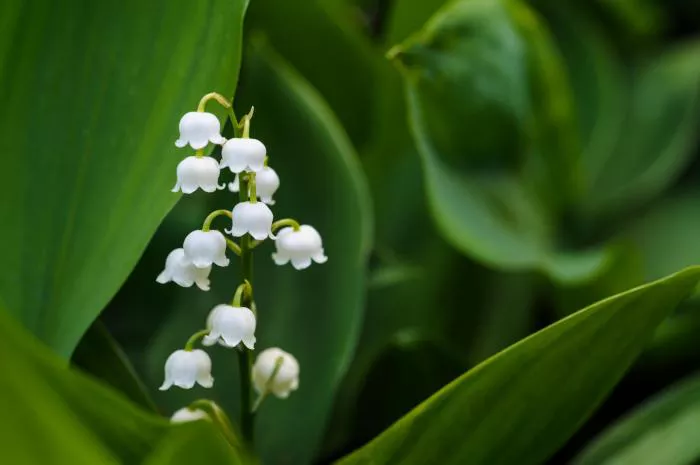Lily of the Valley, known scientifically as Convallaria majalis, is a delicate and fragrant flower that holds deep cultural significance in various societies. With its petite white bell-shaped blossoms, this plant is often associated with purity, humility, and sweetness. In this article, we will explore the symbolism of Lily of the Valley, its historical significance, and its role in different cultures.
Historical Background
Lily of the Valley has a rich history that dates back to ancient times. It is believed to have originated in Europe and Asia. Its sweet scent and beautiful appearance have made it a popular choice in gardens and floral arrangements.
In ancient Roman and Greek cultures, Lily of the Valley was associated with various deities. The flower was dedicated to Venus, the Roman goddess of love and beauty. It was often used in ceremonies and rituals to invoke her blessings.
In the Middle Ages, Lily of the Valley was a symbol of humility and purity. It was often used in religious ceremonies. The flower became a representation of the Virgin Mary, emphasizing her role as a symbol of purity.
Symbolism of Purity and Innocence
Lily of the Valley is widely recognized as a symbol of purity and innocence. Its white blooms evoke a sense of freshness and new beginnings. This flower is often used in weddings and christenings to represent the purity of the individuals involved.
In literature and poetry, Lily of the Valley is frequently mentioned as a symbol of innocence. Poets and writers have used this flower to convey themes of love and devotion. The delicate nature of the blossoms reflects the fragility of innocence and the beauty of pure love.
Significance in Love and Romance
Lily of the Valley is often associated with love and romance. It has been used as a symbol of the return of happiness and the rekindling of love. In the language of flowers, known as floriography, Lily of the Valley conveys the message “You have made my life complete.”
This flower is also linked to the idea of new beginnings in relationships. Its blooming season, which typically occurs in spring, signifies renewal and growth. Couples often choose Lily of the Valley for their bouquets, as it symbolizes their hope for a lasting and joyful relationship.
Cultural Significance
Lily of the Valley holds a special place in various cultures around the world. In France, it is traditionally given as a gift on May 1st, known as Labor Day or May Day. This custom is believed to bring good luck and happiness to the recipient. The flower is often presented in bouquets or as a single stem, making it a cherished symbol of spring and renewal.
In Japan, Lily of the Valley is known as “suzuran.” It symbolizes a return to happiness and is often associated with the hope of a brighter future. The flower is celebrated during festivals and events, where it is used in decorations and offerings.
In Norse mythology, Lily of the Valley was associated with the goddess Freya. It was believed to have protective qualities and was used to ward off evil spirits. This association with protection further emphasizes the flower’s role as a symbol of purity and innocence.
Medicinal Uses
Beyond its symbolism, Lily of the Valley has been recognized for its medicinal properties. Historically, it has been used in herbal medicine for various ailments. Its leaves and flowers contain compounds that can have beneficial effects on the heart.
However, it is essential to note that Lily of the Valley is toxic if ingested in large quantities. All parts of the plant contain cardiac glycosides, which can cause severe health issues. Therefore, while it holds a place in traditional medicine, caution must be exercised.
The Role in Floral Arrangements
Lily of the Valley is a popular choice for floral arrangements due to its elegant appearance and sweet fragrance. It is often used in weddings, bridal bouquets, and special occasions. Its delicate nature adds a touch of sophistication to any arrangement.
Florists often combine Lily of the Valley with other flowers to create stunning bouquets. The contrast of its petite blossoms with larger blooms enhances the overall aesthetic. Additionally, its fragrance adds a layer of sensory experience to the arrangement.
When selecting Lily of the Valley for floral arrangements, it is essential to consider its short vase life. These flowers are best displayed shortly after being cut. Proper care and handling can extend their lifespan, allowing them to be enjoyed for a more extended period.
Folklore and Myths
Various folklore and myths surround Lily of the Valley. In some cultures, it is believed that the flower brings good luck and protects against evil spirits. It is often featured in stories and legends, adding to its mystique.
In French folklore, it is said that if a maiden finds Lily of the Valley blooming in the woods, it will bring her happiness and love. This belief further cements the flower’s connection to love and romance.
In contrast, some legends caution against picking Lily of the Valley. It is believed that if the flower is plucked, it may bring misfortune or sadness. This superstition adds to the flower’s enigmatic reputation.
See also: What Is The Meaning Of Peruvian Lily
Conclusion
Lily of the Valley is more than just a beautiful flower. It carries profound symbolism and cultural significance. From its associations with purity and innocence to its role in love and romance, this delicate plant captivates hearts around the world.
As we appreciate the beauty of Lily of the Valley, we also recognize its place in history and culture. Whether given as a gift, used in floral arrangements, or celebrated in folklore, this flower continues to inspire and evoke emotions.
In summary, Lily of the Valley symbolizes purity, love, and renewal. Its presence in gardens and homes serves as a reminder of the beauty and fragility of life. Embracing the symbolism of this flower can bring joy and inspiration to our lives.
Related topics:


